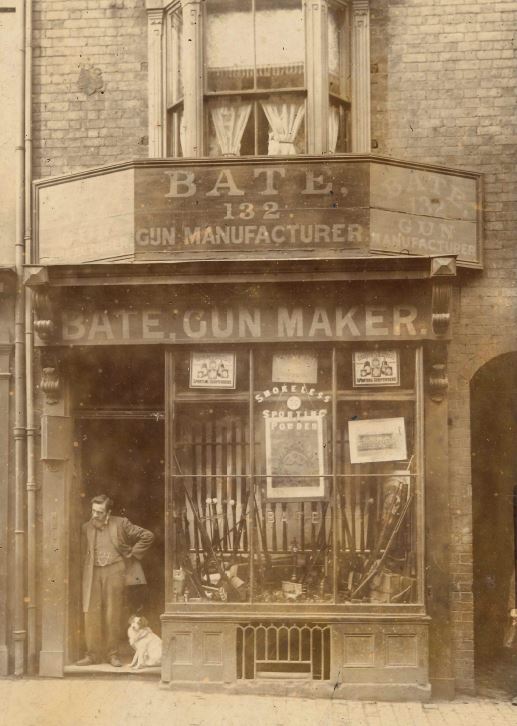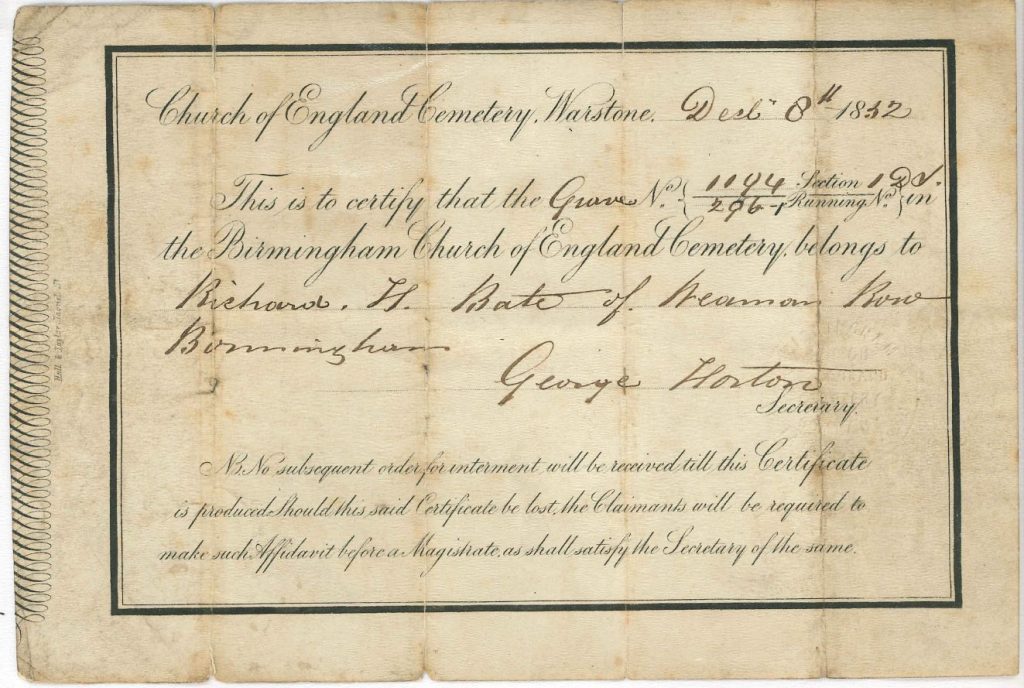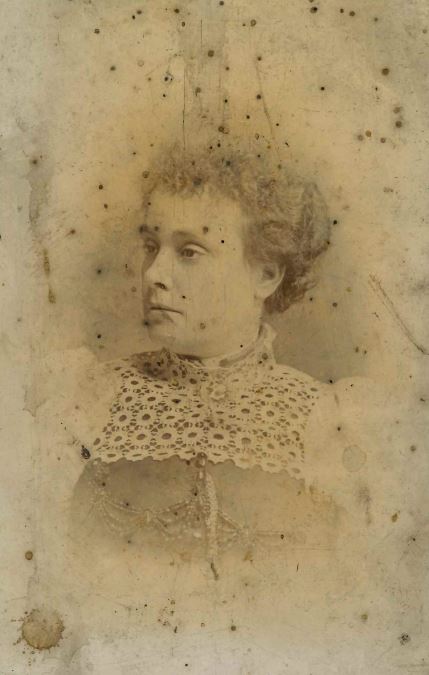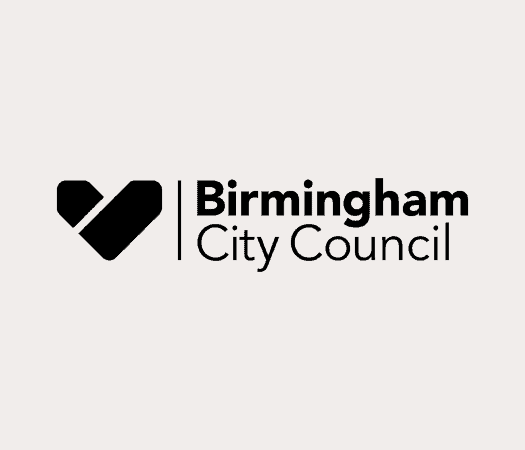Richard Jones is a member of the JQ Heritage Squad. He has been helping with Outdoor Conservation and researching some of the people buried in the cemeteries. He also has a personal connection to Warstone Lane, through his ancestors – the Bate family:
Richard Henry Bate
Richard Henry Bate born 1807 (my Gt-Gt-Gt Grandfather) married Mary Ann Hart in 1832 at St Mary’s church in Handsworth. They moved to Birmingham city centre, and they lived in the gun quarter before moving to Tenant street off Broad street where Richard became a shop keeper around 1840.
Richard’s fortunes changed in 1843 when his grandmother Elizabeth Swinbourn (nee Payton) died and left him a sizable sum of money in her Will. After his grandmother’s death Richard went into the gun trade, and he set-up his own gun shop in 1855 at 132 Steel House Lane, which he ran until his death in 1880. Richard ran his business successfully, manufacturing a series of guns personalised with his name, but his wife Mary Ann Bate (nee Hart) died in 1863.
After his wife died he lost his way in life becoming a bit of a womaniser, and he even appeared in court in 1873 where he accused his new bride to be of being an alcoholic woman of loose morals. The newspaper report of the trial said it was a bit of a farce, and everyone including the judge couldn’t help but laugh. The judge made him pay compensation to her for the money she spent on their cancelled wedding (£25).
Quotes from The Royal Leamington Spa Courier, July 12 1873, The Birmingham Breach of Promise Case, page 7:
‘Richard Henry Bate, the defendant, was then called and examined by Mr Field, who remarked “Here is the gay Lothario.” The defendant is a staid and plain looking old man, and his appearance and the singular mode in which he gave his evidence caused much amusement’
‘His Lordship said that if the defendant gave a woman a promise to marry under the circumstances which had been detailed, he must take the consequences. The case was an illustration of the saying, “There’s no fool like an old fool.” (Laughter.)’
Richard later remarried in 1876 to Sarah Cowley Aspley. After Richard died his son George took over the running of the shop until he died in 1908.
When George took over the business in 1880 it was £150 in debt. Although he spent the next 7 years trying to clear the debt, the creditors gave him little or no relief, and because of George’s ill health the debt rose to £516 (over £40,000 in today’s money). After the case was brought up in court the creditors agreed to accept 20% of the debt, and this was paid back in a year.

Richard purchased the family grave, Section D Grave 1194 in Warstone Lane Cemetery after one of his children died in 1852. The grave contains 8 people; Richard, his wife Mary Ann, 3 children who died young (Thomas Elias, Ann Maria and Martha Emma), his son called George and George’s wife Mary Ann Parrish and her mother Mary Parrish.

George Bate and Mary Ann Bate
Two months before George died his wife Mary Ann Bate (nee Parish) fell down the stairs in their gun shop and she died. The family said when she died George was distraught, and he felt he had nothing else to live for.
Mary Ann’s mother was called Mary Parish. In the early 1850’s Mary Parish’s marriage to her husband Henry Parish broke down, and Henry went to live with his brother in Australia leaving Mary to be supported by her children until her death in 1894. In 1875 Henry Parish died when was making explosives at his business in Australia, and the gunpowder ignited causing a massive explosion.
Richard Henry Bate Junior
Richard Henry Bate Junior (son of the above Richard Henry Bate) was buried in 1879 in public grave (Section I, Grave 1928), and not with the rest of the family, probably because Richard was a bigamist.
Richard was an apprentice gun barrel maker in his father’s gun shop, and later at the age of 21 whilst working in the gun trade he married Elizabeth Winwood in 1855 at St Mary’s church Handsworth, and they moved to Aston where Richard worked as a furniture maker and pin maker, and they had three children together. Unfortunately, two of the children died aged three.
In 1862 Richard met Rebecca Mason, and they had two children together, but they never married probably because Richard was still married to Elizabeth.
Richard’s first child with Rebecca (Herbert) was conceived whilst he was still in a relationship with Elizabeth, but just after he was born, Richard separated from Elizabeth.
Although Richard was no longer a Gun Barrel Maker, he continued to state that on some official records. Whether it was to avoid identification or because he was embarrassed about his current career I do not know.
All Richard’s children lived with Richard and Rebecca, but Elizabeth still had contact with her children. Richard had one further child with Rebecca.
Richard was now a pram maker living in Sparkbrook, unfortunately, his second relationship ended in separation as well.
A few months after separating from Rebecca, in 1872 he married Sarah Ann Moseley at the Edgbaston parish church. On his marriage certificate he gave false details, probably because he was still married to Elizabeth, and she was living in the same parish at the time of the marriage.
Richard and Sarah soon moved to the Jewellery Quarter and later to Mott Street where Richard continued to make prams. Sarah helped bring up Richard’s children, and they had two children of their own before Richard died in 1879.






